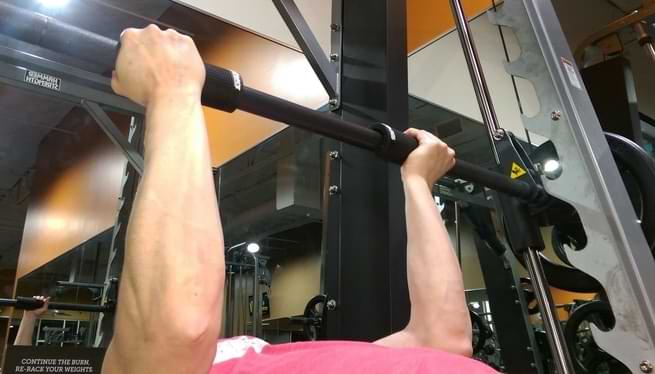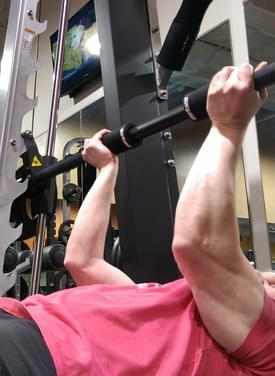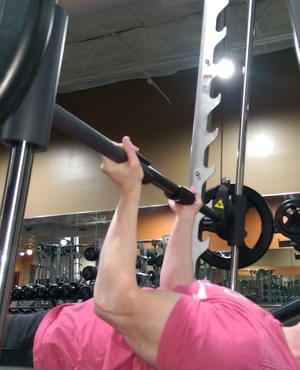The Reverse-grip barbell press is a great exercise to build bigger and stronger pecs, triceps, and delts. Unfortunately, straight barbells are not ergonomically designed for you to grip comfortably without straining your wrists when doing reverse-grip presses.
Plus, the more weight you add to the barbell, the more discomfort you may experience. Ultimately, the added wrist strain will prevent you from lifting heavier weights and diminish your progress going forward.
I, for one, love performing reverse-grip barbell presses on an incline to target my front delts. It gives me that excruciating burn and pumps I look for and appreciate. And as we all know, this is what grows muscle tissue.
I thought about what I could do to correct my grip’s angle to make it more ergonomic and less painful to my wrists. Maybe I could stuff something into my gloves? Or perhaps wrap something around the barbell to create that extra cushion between my hand and the bar?
How I Fixed My Reverse-Grip Barbell Press Wrist Discomfort
Surprisingly and as if meant to be, I stumbled upon a pair of grips on Amazon while shopping for other products. I know what your thinking – it sounds awfully coincidental and convenient. But I promise you, it never crossed my mind to use a thick grip for this issue.
So yes, I was amazed and thrilled to find these grips. So rather than making my own gadget, I decided to drop some coin and test whether a thick grip would help.
Improve Your Reverse-Grip Barbell Press with Thick Grips
There are many barbell grips on the market today, but since I already had a pair of my own, I thought I’d give them a try first.
I planned to position the thick grips on the barbell to use half of the grip under the outside of my palm (or pinky side). I figured this would create a better angle and result in less strain on my wrists.
With that in mind, I decided to head to the gym the very next day give it a try.
So here is what I found:
Firstly, I was concerned whether these grips would be dense enough to support a tight grip and heavier weights. And my second was if the thickness would compromise my grip.
The grips I own are very dense and pretty solid. The thickness of these grips also looked promising. My thick grips measure 2” wide, with the outside edge being ⅜” thick. That ⅜” is what will slightly drop my wrist position and hopefully be enough to help my wrists feel better.
And so I decided to put them to the test. Here are the three exercises I used them for and my results.
Three Reverse-Grip Exercises Tested
Reverse-Grip Shoulder Press: So I decided to use them first on the smith machine for reverse-grip shoulder presses with an incline bench.
Attaching my grips to the barbell was relatively easy and took no more than a second each. I then positioned the grip halfway across the outside of my palm and the other side onto the barbell – giving me extra padding on the pinky side of my palm.
I honestly can’t tell you how incredibly comfortable these were on my hands and wrists. Finally, I was able to focus entirely on my workout routine without being distracted by my wrist discomfort.
Furthermore, without any wrist discomfort, I was also able to add much more weight than before.
Now that in itself is a game-changer!
Reverse-Grip Barbell Bench Presses:
I thought I’d give these a try with a free weight barbell rather than the smith machine. In this way, I could better gauge how secure my grip would be using the thick grips.
Again, I was pleasantly surprised by how well I could grip the bar and that it took no extra effort to secure my grip.
The change in wrist position once again made it possible for me to add extra weight to my bench press. Something I was unable to do before due to the unnatural angle and pressure on my wrists.
Again, I was pleasantly surprised by how well I could grip the bar and that it took no extra effort to secure my grip.
The change in wrist position once again made it possible for me to add extra weight to my bench press. Something I was unable to do before due to the unnatural angle and pressure on my wrists.
Reverse-Grip Triceps Cable Extensions: Another favorite of mine is reverse-grip extensions using a cable machine. However, once you start adding some heavier weights, it starts to really dig into your wrists.
I first tried my thick grips on a padded short-bar. The padding, however, added too much thickness to the bar. Which, in turn, made it difficult to grip.
Unfortunately, I do not have non-padded short bars at our gym, so I reverted to a long cable pulldown bar instead.
And as I expected, it worked perfectly! Of course, if you have access to an EZ-bar, that would be the way to go. Then you wouldn’t need the grips altogether.
Here is How My Reverse Grip Presses have Improved
- Less wrist strain and wrist discomfort
- I can concentrate more on my workout and less on my wrists
- Able to add significantly more weight to my reverse grip presses
- Have become stronger as a result
All-in-all, this one change has helped increase my performance dramatically. I have never before felt so good doing reverse grip barbell presses.
I can feel myself getting stronger while lifting heavier weights than before, and I know this will help activate more muscle fibers and spur new growth.
My Recommendation
If you already own a pair of fat grips, then, by all means, give them a run and see how they work for you. Otherwise, here are few thick barbell grips I would recommend that will not break the bank:
A Better Way to do Reverse-Grip Barbell Presses
All in all, using the barbell grips turned out to be a far better way to do reverse-grip barbell press. They even performed well with reverse-grip tricep extensions on a cable machine.
The improved ergonomics these grips provide make any reverse-grip exercise using a barbell feel much more natural by providing more surface area where it matters.
I would highly recommend these to anyone wanting to add more weight to your reverse grip exercise while also taking away the wrist discomfort.
You can use these grips on any Olympic size barbell, including dumbbells, to improve your grip, take the pressure off your palms, and reduce the strain on your wrists.

With over 30 years of experience in strength training and fitness, Mark LaRue is the founder of Fitness Mastered, a blog to help educate fitness enthusiasts of all fitness levels, ages, and gender. We write topics that range from weight training tips and exercise routines to home workout machine and fitness related product reviews, to name a few.



